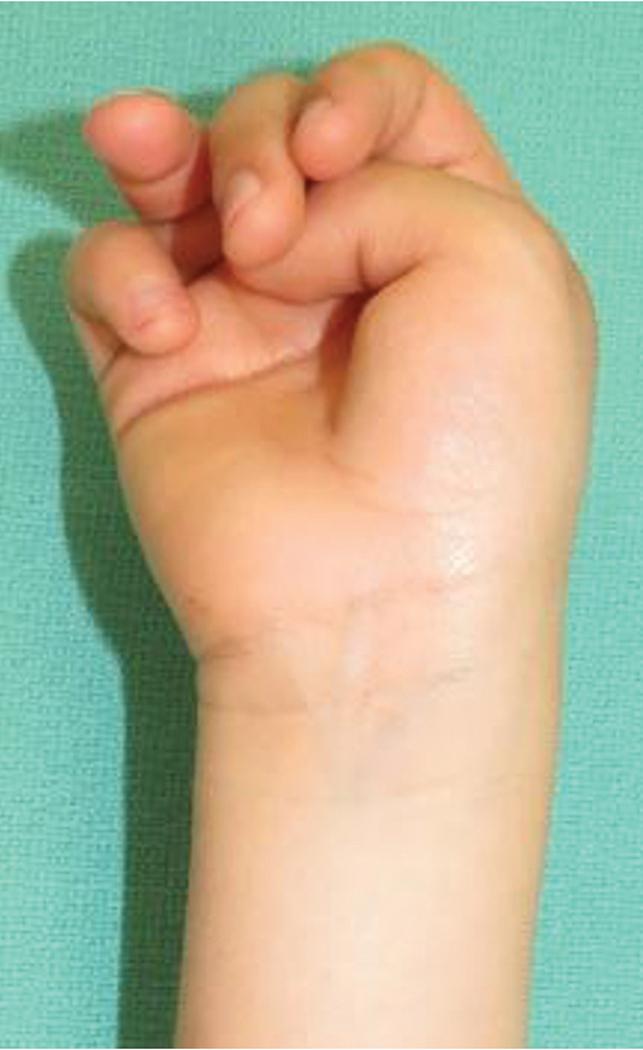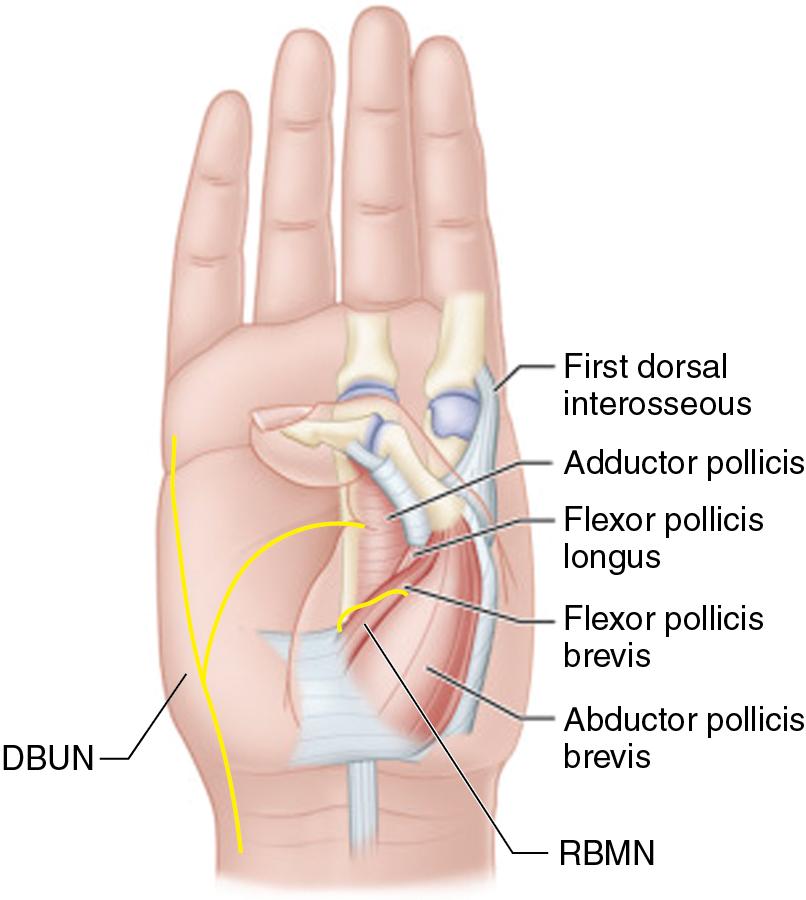Physical Address
304 North Cardinal St.
Dorchester Center, MA 02124
Cerebral palsy patients may develop spastic contracture of thumb adduction and flexion muscles, which causes a characteristic thumb-in-palm deformity ( Fig. 102.1 ).

House described four types of thumb-in-palm deformity:
Type 1: First ray adduction across the palm from contracture of the adductor pollicis (AdP).
Type 2: First ray adduction with flexion of the metacarpophalangeal joint (MCP) from contracture of flexor pollicis brevis (FPB).
Type 3: First ray adduction with volar plate laxity leading to MCP hyperextension.
Type 4: First ray adduction with MCP flexion and interphalangeal (IP) joint flexion from contracture of the flexor pollicis longus (FPL).
Surgical correction is indicated if:
A patient is functionally unable to grasp and pinch objects because of the malpositioned thumb, and conservative measurements have been exhausted (such as aggressive hand therapy, thumb abduction splinting, and botulinum toxin injections).
To facilitate hygiene using a nonfunctional hand.
Surgical correction of thumb-in-palm deformity requires (1) release of contracted intrinsic and/or extrinsic muscles, (2) augmentation of weak muscles, and (3) stabilization of joints. For Type 1, release of the AdP from the metacarpal origin may also be necessary. Various adjunct procedures may also be indicated ( Table 102.1 ).
| Deformity | Surgery |
|---|---|
| Thumb contracture (with MCP flexion) | Release of FPB, APB, FDI |
| Thumb contracture (with MCP and IP flexion) | Release of FPB, APB, FDI, and FPL lengthening |
| Soft tissue deficit in first webspace | Thumb webspace z-plasty or locoregional flap |
| Weak thumb extension and abduction | EPL rerouting Augmentation of EPL, EPB, or APL with tendon transfers (e.g. brachioradialis, palmaris longus, extensor carpi radialis longus) |
| Joint instability | CMC, MCP, or IP arthrodesis. MCP volar plate capsulodesis. |
Patients without sufficient voluntary muscle control, cognitive ability, or motivation to rehabilitate after surgery should not undergo thumb adductor release (unless it is for hygienic issues).
Patients must have adequate shoulder, elbow, forearm, and wrist function to position the hand in a posture that permits use of thumb grip and pinch.
For patients with cerebral palsy, a complete examination of the upper extremity is needed to understand the potential function and posture of each muscle and joint.
Spastic contracture often manifests as shoulder internal rotation, elbow flexion, forearm pronation, wrist flexion, wrist ulnar deviation, and thumb-in-palm deformity.
Proximal procedures are necessary first if the hand cannot be placed in a favorable manner for utilization of thumb grip and pinch.
Hand and thumb examination:
Visually inspect the position of the first ray in relation to palm. Determine whether there is adequate first webspace soft tissue to permit abduction and extension of the thumb.
Palpate the thenar eminence to assess for contractures of involved muscles. Note which muscles need release.
Passively and actively assess range of motion (ROM) at the thumb CMC, MCP, and IP joints. Evaluate for hyperextension and volar plate laxity of MCP. Determine whether any joints need stabilization.
Assess strength of flexion, extension, adduction, abduction, and opposition of the thumb. Consider whether muscles require augmentation with tendon transfers.
Observe hand function. Determine whether the thumb-in-palm deformity inhibits the patient’s ability to grasp objects and oppose the thumb against the fingers.
The following intrinsic muscles may have contractures ( Fig. 102.2 ):
Adductor pollicis (AdP): Consists of an oblique head and a transverse head, which originate from the capitate, the base of the second and third metacarpals, the volar intercarpal ligament, and the sheath of the flexor carpi radialis (FCR) tendon. The AdP inserts on the ulnar base of the thumb proximal phalanx.
Flexor pollicis brevis (FPB): Consists of a superficial head and a deep head, which originate from the trapezium and transverse carpal ligament and trapezoid, capitate, and the distal carpal row volar ligaments, respectively. The FPB heads both insert on the radial base of the thumb proximal phalanx.
Opponens pollicis (OP): Lies deep to the APB, originates from the trapezium and transverse carpal ligament, and inserts onto the volar radial side of the thumb metacarpal.
Abductor pollicis brevis (APB): Lies radial to the FPB on the superficial (proximolateral) aspect of the thenar eminence. The APB arises from the transverse carpal ligament, trapezium, and scaphoid and inserts onto the radial base of the thumb proximal phalanx.
First dorsal interosseous (FDI): Originates on the radial side of the second metacarpal and the ulnar side of the first metacarpal. The FDI inserts on the radial side of the base of the second proximal phalanx and the extensor apparatus. The FDI muscle lays on the dorsum of the AdP, and together these muscles make up the mass of the first webspace.

Nerves at risk during thenar myotomy:
Deep branch of the ulnar nerve (DBUN): Enters the hand via the Guyon canal, travels with the deep palmar arterial arch, and terminates between the two heads of the AdP. The DBUN is at risk for injury during release of the AdP from its metacarpal origins.
Recurrent branch of the median nerve (RBMN): The RBMN is most commonly extraligamentous, with a takeoff immediately distal to the TCL. The nerve then travels radially, crosses over the FBP, and terminates in the thenar musculature. The RBMN is at risk for injury during release of the FBP, OP, and APB.
Common digital nerves to the long and index fingers: These nerves lie on the lumbricals and run longitudinally toward the digits.
Become a Clinical Tree membership for Full access and enjoy Unlimited articles
If you are a member. Log in here